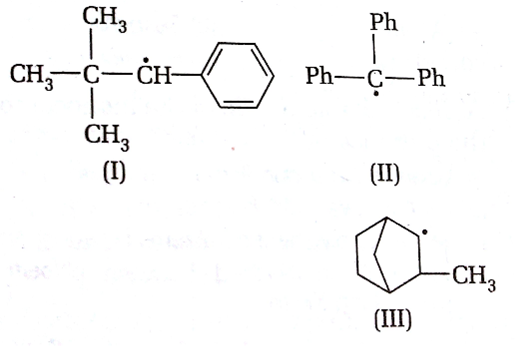 Multiple Choice Questions
Multiple Choice QuestionsConsider the following compounds
Hyperconjugation occurs in
I only
II only
III only
III only
The enolic form of ethyl acetoacetate as below has
18 sigma bonds and 2 pi-bond
16 sigma bonds and 1 pi-bond
9 sigma bonds and 2 pi-bond
9 sigma bonds and 2 pi-bond
'Metals are usually not found as nitrates in their ores'
Out of the following two (a and b) reasons which isare/are true for the above observation?
I. Metal nitrates are highly unstable.
II.Metal nitrates are highly soluble in water.
I and II are true
I and II are false
I is false but II is true
I is false but II is true
Because of lanthanoid contraction, of elements which of the following elements have nearly same atomic radii ? (Number in the parenthesis are atomic number).
Ti (22) and Zr(40)
Zr(40) and Nb (41)
Zr (40) and Hf (72)
Zr (40) and Hf (72)
C.
Zr (40) and Hf (72)
Because of the lanthanoid contraction Zr (atomic radii 160 pm) and Hf (atomic radii 158 pm) have nearly same atomic radii.
Lanthanoids include the elements from lanthanum La (Z=57) to lutetium Lu(Z =71).Zirconium Zr (40) belong to the second transition series (4d) and Hf (72) belongs to third transition series (5d). Lanthanoid contraction is associated with the intervention of the 4f orbitals which are filled before the 5d- series of elements starts. The filling of 4f if orbitals before 5d orbitals result in a regular decrease in atomic radii which compensates the expected increases in atomic size with increasing atomic number. As a result of this lanthanoid contraction, the elements of second and third transition series have almost similar atomic radii.
Which of the following processes does not involve oxidation of iron?
Rusting of iron sheets
Decolourisation of blue CuSO4 solution by iron
Formation of Fe(CO)5 from Fe
Formation of Fe(CO)5 from Fe
Which of the following options represents the correct order?
O2-> O2>O2+
O2-<O2<O2+
O2->O2<O2+
O2->O2<O2+
Nitogen dioxide and sulphur dioxide have some properties in common. which property is shown by one of these, comounds but not the order?
Forms acid -rain
Is a reducing -agent
Is a soluble in water
Is a soluble in water
The maximum bond angle at nitrogen is present in which of the following?
NO2
NO2-
NO2+
NO2+
Which of these statements about [Co(CN)6]3- is true?
[Co(CN)6]3- has no unpaired electrons and will be in a low-spin configuration.
[Co(CN)6]3- has four unpaired electrons and will be in a low-spin configuration
[Co(CN)6]3- has four unpaired electrons and will be in high-spin configuration.
[Co(CN)6]3- has four unpaired electrons and will be in high-spin configuration.
